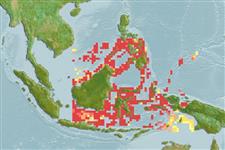Common names from other countries
Environment: milieu / climate zone / depth range / distribution range
экология
. Tropical; 23°C - 30°C (Ref. 102835); 13°N - 9°S, 109°E - 139°E (Ref. 106696)
Western Central Pacific: Restricted in the tropical western Pacific. From Sabah, Malaysia to Palau, north to Philippines and south to Indonesia.
Length at first maturity / Size / Вес / Возраст
Maturity: Lm ? range ? - ? cm Max length : 41.1 cm SHL самец/пол неопределен; (Ref. 117184); common length : 20.0 cm SHL самец/пол неопределен; (Ref. 348)
Its shell is thinner and smoother than that of H. hippopus, usually devoid of pigmentation, and more semi-circular in profile. The mantle is similar to that of H. hippopus (Rosewater, 1982), except that prominent papillae line the margins of the incurrent siphon.
Collected for food and shell (Ref. 348). Found in shallow waters. Young specimens often byssally attached to coral heads, mature specimens lack a byssus and lay unattached on the substrate (Ref. 348).
Life cycle and mating behavior
половая зрелость | размножение | нерест | икра | Fecundity | личинки
Broadcast spawners. Life cycle: Embryos develop into free-swimming trocophore larvae, succeeded by the bivalve veliger, resembling a miniature clam (Ref. 833).
Основная ссылка
ссылки | координатор | соавторы
Poutiers, J.M. 1998. (Ref. 348)
Статус Красного Списка МСОП (Ref. 130435)
Статус СИТЕС (Ref. 108899)
Not Evaluated
Угроза для людей
Harmless
Использование человеком
рыболовство: коммерческий
FAO - аквакультура (рыбоводство): production; | FishSource | Sea Around Us
инструменты
дополнительная информация
ресурсы в Интернет
Estimates based on models
устойчивость к внешним воздействиям
низкий, минимальное время удвоения популяции 4.5-14 лет (K=0.13).
Уязвимость
Low to moderate vulnerability (30 of 100).
Категория цены
Unknown.
